
Vera Glushkova, senior researcher at the Kiev Institute of Cybernetics, is now studying the history of computing. In the first part of the interview to the DataArt museum project dedicated to her father, the outstanding scientist Viktor Glushkov, Vera Viktorovna tells how he became the youngest academician of the USSR, about international recognition, the creation of the Institute of Cybernetics and the first automated control systems.
(In the photo Vera Viktorovna with her father. Around 1970)
Illumination on the Georgian Military Highway
- My father came to Kiev in 1956 - after defending his doctoral dissertation, in which he proved Hilbert's fifth generalized problem. In 1900, at a congress in Paris, the German mathematician David Hilbert posed 23 problems, most of which have not yet been solved. When his father chose one of them as the topic of his dissertation, the teacher told him: "Vitya, you'd better take some other problem, and then you will solve this one." But dad had a stubborn character, he said that he would deal with her.

Victor Glushkov in the mountains. This and other photos from the family archive are provided by V.V. Glushkova
My father said that the decision came to him while walking along the Georgian Military Highway: “I looked at some kind of tattered fence, and then it dawned on me.” In his life, he experienced many different emotional situations, great love, friendship. But the feeling that he experienced in the Caucasus is incomparable with anything.
Then my father tested this decision for a whole year, and it turned out to be correct. The defense of a thesis on such a problem brought him to the world elite of algebraists, he was invited to France and other countries. The father was offered to continue working in Moscow, Leningrad and Kiev. The family council chose Kiev.
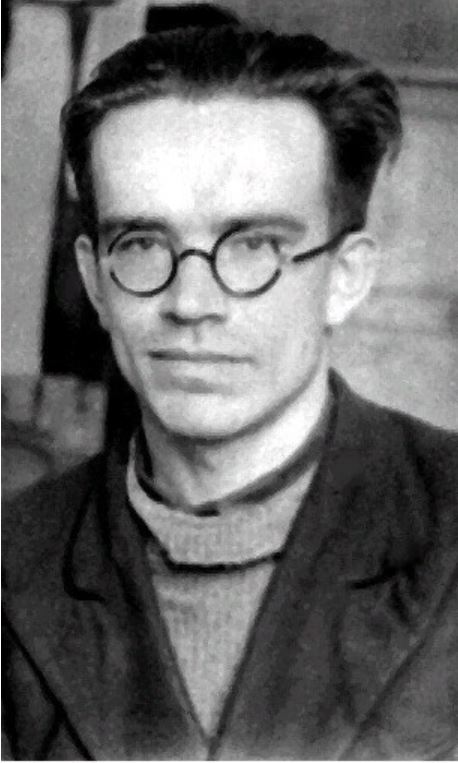
Viktor Mikhailovich Glushkov during his postgraduate studies
Childhood
Since childhood, my father was engaged not only in mathematics, but also in technology. His dad graduated from the Yekaterinoslav Polytechnic - in Dnepropetrovsk (Dnipro). As an independent observer, he took part in the negotiations between the Red Army and Batka Makhno. I remembered how Makhno held meetings. He raised his pistol and said: “We will vote. Who is against? " So democratic. Colt and a kind word are always better than just a kind word.
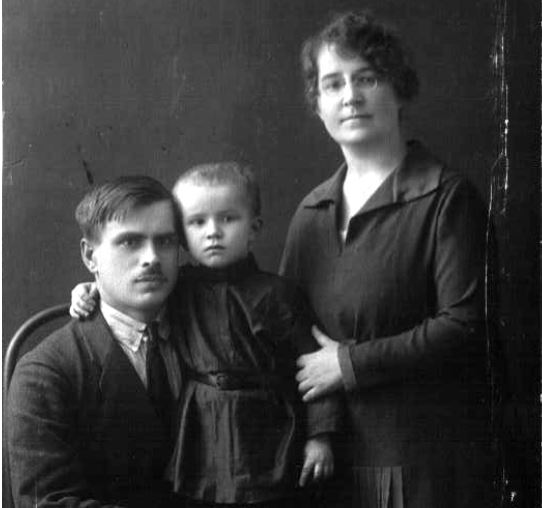
Victor Glushkov with his parents
Grandfather did a lot with dad. At first, they made controlled cars together. Then, in his school years, an electron gun - his father calculated the flight path of the charge. In military affairs, this is one of the most well-known tasks, which is used, among other things, for ballistic and other missiles. They also made their first TV. Few people know that the first experimental television existed in the USSR back in the 1930s: in Moscow, Leningrad and Kiev. Radio receivers, of course, were collected. That is, my father was familiar with technology and mathematics. He also loved physics. He said: "I already knew at the age of 5 that I would be a physicist or a mathematician." Somewhere in the 6th grade, he decided what he needed more and chose mathematics. Materials passed ahead of schedule. Already at school he studied university textbooks on higher mathematics. I once tried toobut she did not win for more than a year in advance.

Victor Glushkov - schoolboy
Bread Line Exam
When my father finished school, the war began. I tried to volunteer for the front, but they didn’t take him because of his sight. The family tried to leave, but the Germans took them into the cauldron. I had to go back to Mines and stay in the occupied territory. My grandmother Vera was a member of an underground organization and was one of its leaders. Dad made radios for them. One day, when he was walking home, he was told: “Vitya, do not come back. Your mother was taken to the Gestapo. " I went out of town with another guy, lived in an abandoned house, ate frozen horse meat and went to the Gestapo almost every day, hoping to see my mother over the fence. But she was shot.
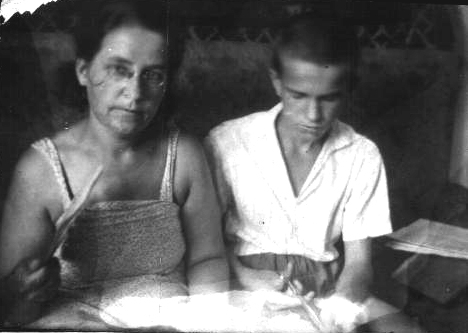
Victor Glushkov with his mother Vera Lvovna
Because the Pope was in the occupied territory, he was not accepted to the institute either in Moscow or in Leningrad. I was able to enroll only in Novocherkassk. Now it is the Polytechnic University, then - the Novocherkassk Industrial Institute. In the third year, he realized that he still needed to do mathematics, and applied to Rostov University. There it was necessary to retake almost 20 subjects. Arriving in Rostov, dad slept at the station. Where I found a teacher, I passed it there. He said that he handed in astronomy in line for bread - he drew a map of the starry sky on the back of the teacher. He successfully passed all the exams and graduated from Rostov University. It turned out, as it were, a double education: when he became more or less famous, after the fact he was awarded an engineering diploma from the Novocherkassk Industrial Institute.
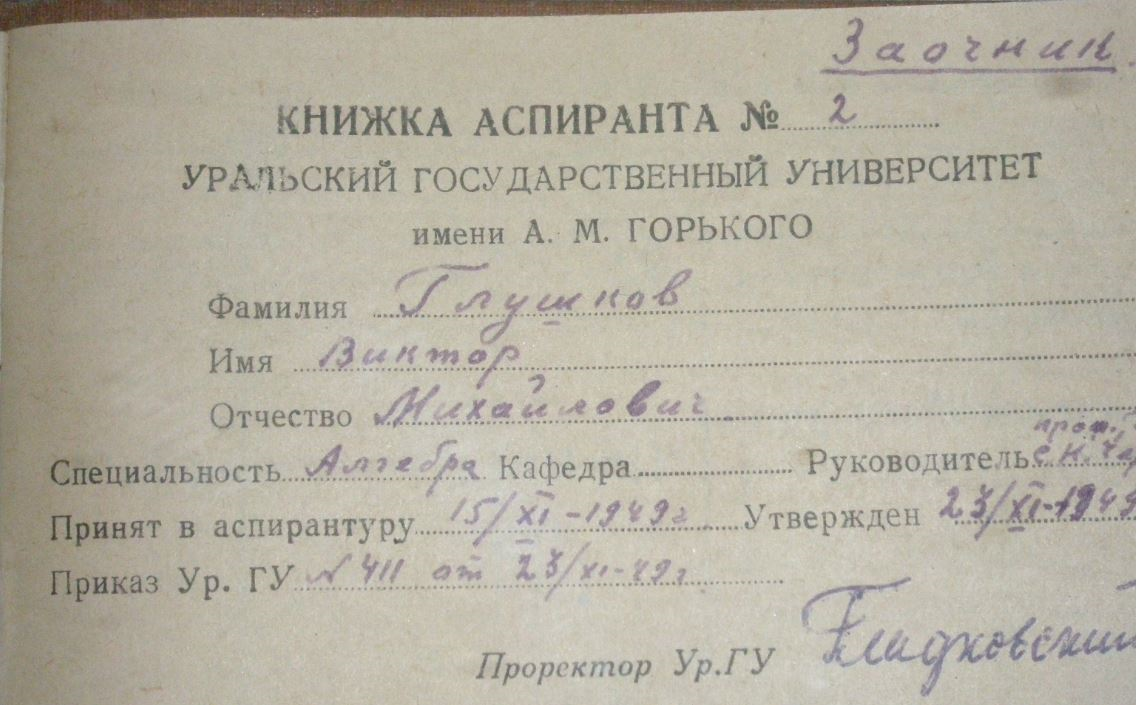
The book of a postgraduate student of the Ural State University
After the institute, he and his mother went to the Urals on assignment. In Sverdlovsk, my father was in graduate school, worked as an assistant at the Forestry Institute, defended his Ph.D. in pure mathematics. Then - a doctorate on the problem of Hilbert.
The youngest academician
In Kiev, dad came to the place of Sergei Alekseevich Lebedev, who moved to Moscow. His laboratory in Feofaniya was located neither more nor less in the temple of St. Panteleimon. By the way, I was later baptized in this church. I did not know where I would be baptized, they took me there. And this was exactly where my father started working.
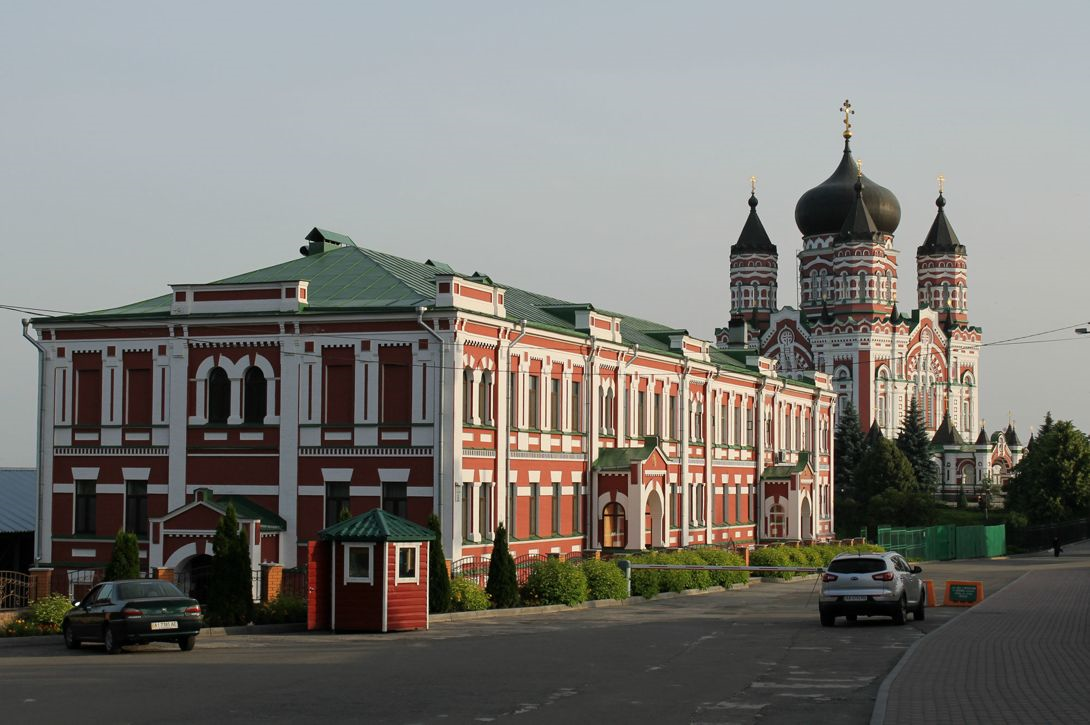
St. Panteleimon Cathedral in Feofaniya (now the Goloseevsky district of Kiev) was built in 1905-1912. In 1990, the building was transferred to the Ukrainian Orthodox Church
In this laboratory for computer technology, which belonged to the Institute of Mechanics, Lebedev in 1952 made MESM - a small electronic calculating machine. This is the first memory car in continental Europe. Lebedev was immediately taken to Moscow, where he created the famous BESM-6. Well, the laboratory was headed by Glushkov. He began to expand it, recruiting employees himself. I went to universities in Ukraine, attended the defense of diplomas in order to find people with a good mathematical background.

Viktor Glushkov (left) with Viktor Charin (center) during a conference in Leningrad. 1950s
In 1957, dad created the Computing Center - the computing center of the Academy of Sciences, which in 1962 was transformed into the Institute of Cybernetics, and at the age of 30 he himself became the youngest academician, first in Ukraine, then in the USSR. Further - Vice-President of the Academy of Sciences of Ukraine, Deputy Paton. He retained this status until the end of his days.

Certificate of the Vice-President of the Academy of Sciences of the Ukrainian SSR, issued to Viktor Glushkov in 1967
Creation of the Institute of Cybernetics
In 1997, 15 years after his father's death, the Americans awarded him the "Computer Pioneer" medal. It is very prestigious, only a few scientists from the USSR received it. They are awarded in 15 years so that the scientist's contribution to world science is better seen. He was awarded for three achievements (usually awarded for one, maximum two), in particular, for the creation of a unique Institute of Cybernetics.
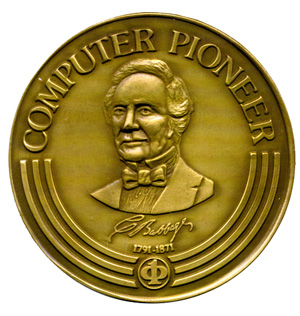
The Computer Pioneer Medal is the most prestigious award of the IEEE Computer Society, established in 1981
The phrase “digital sovereignty” is very fashionable now. It was for him that dad did the Institute of Cybernetics. There were all the stages of creating information technology. Everything that was in the world, including directions in artificial intelligence. As soon as he hears something somewhere, the department immediately opens, work begins in this direction. We had an experimental plant, a design bureau, separately - programmers who wrote not only applications, as now, but translators, interpreters, Android or Windows scale systems. There was a theoretical department - I later worked in it, a space department - there was a lot of space, military topics are more than half of the Institute's work. In the best years 6 thousand people worked for us. To be honest, I don't know a single plant, not a single large enterprise in Ukraine, with which our Institute of Cybernetics would not cooperate.In the Soviet Union, too, no less, because Glushkov was the main consultant for the automation of the USSR defense industry.
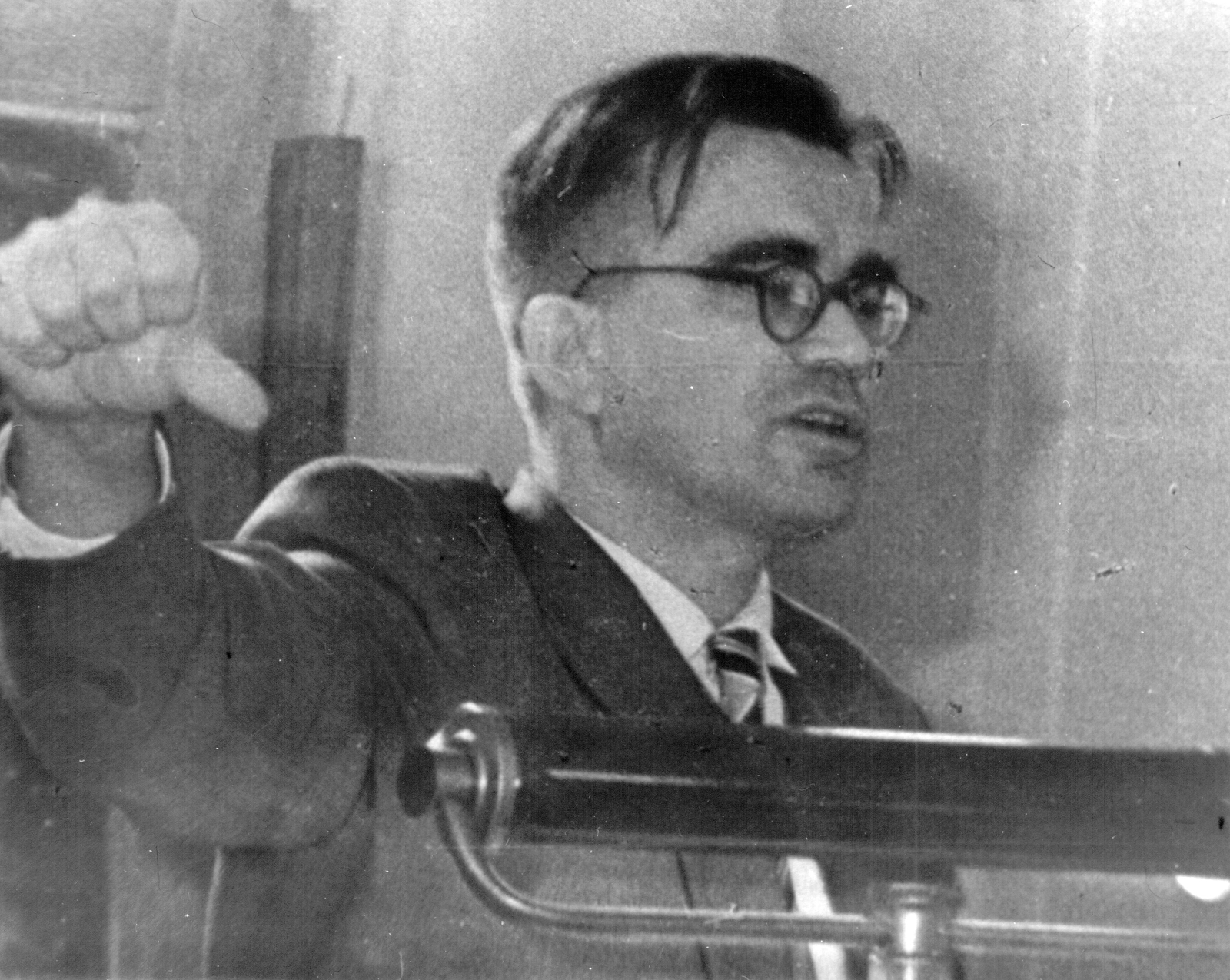
Speech at an international congress, 1960s
They created the famous "nine" - nine institutes for the types of troops - land, aviation, etc. He directed their work. In addition, they were engaged in various military developments - on-board computers for submarines, aircraft. We made a unique air defense system, participated in the development of the Grad system - this is only what I know, and, unfortunately, I know little. We did a lot of automation for sure: the Jupiter system for the navy, the bases of the Ministry of Internal Affairs and the KGB - not only in Ukraine, but also in the USSR. The main oil pipelines of the Soviet Union, the calculation of the BAM profiles, the Ulyanovsk Aviation Plant were automated. I don’t know what they didn’t automate. My friend went to the Ostankino TV tower - she was also engaged in some kind of automation. My father was in charge of IT support for the 1980 Olympics.
I think it was at our institute that they knew the country's economy best of all. My father proposed a nationwide automated control system, so a lot was studied, including the information flows of the economy of the Soviet Union, the workflow at each enterprise, and so on. A colossal job has been done.
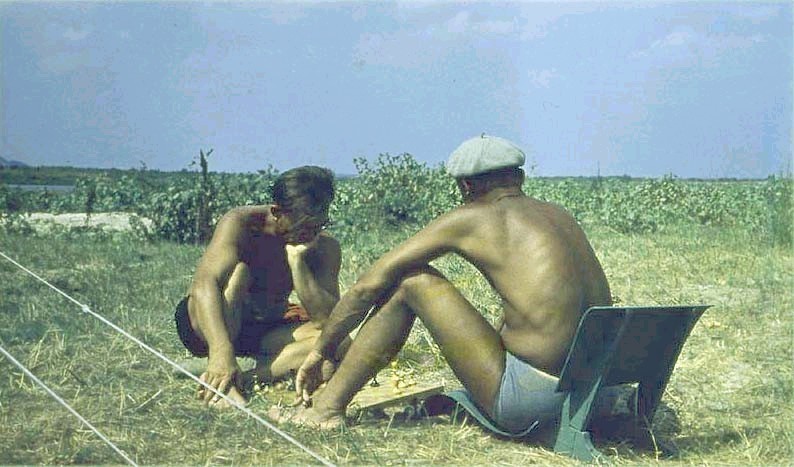
Viktor Glushkov on vacation plays chess with his former graduate student Vitaly Derkach , 1970s. Chess was Viktor Mikhailovich's passion
When I studied the work on an automated control system in Bulgaria, I managed to find, God forbid, a quarter of the materials - not everything then ended up in libraries. Still, a simple listing - the name of the project, how many people participated - took me 12 pages of printed text. This is just one project that no one remembers now. I am silent about the rest. About the defense industry, for example.
Information Barriers Theory
Glushkov had an interesting theory - the so-called theory of information barriers. I think it is still very relevant today. When the Pope proved what the state automated system is for, he based it on this theory. He considered the history of mankind from the standpoint of the amount of processed information. There were two points of view - technological and managerial.
In terms of technical means, he identified three information barriers. The first was when the amount of information increased so much that writing was invented. The second - when it increased so much that at the end of the 15th century the printing press began to be used. I emphasize: to be used, because it was invented much earlier. It is after this that the development of capitalism, modern industrial revolutions and so on begins. The third barrier is when the amount of information has increased so much that control without a computer has become impossible.
From a management point of view, the Pope identified two information barriers. The first was when a tribe could be ruled by one person. Then the amount of information increased so much that it became necessary to parallelize control. There were assistants, priests, castes ... All this grew into the bureaucratic apparatus that we see now. And in the middle of the twentieth century, a situation arose when the amount of information increased so much that the computer becomes a necessary and integral part of management. In the 1970s, the Institute of Cybernetics carried out calculations and made sure that, if not using computers, then in order to draw up a five-year plan - and the Soviet Union lived on five-year plans - it would have been necessary to plant the entire adult population of the country, and the calculation of the plan would take whole year. There was a range of manufactured products - 20 thousand items.By this, my father argued that if you do not include electronic computers in the control system, management will be ineffective, and economic lagging will be inevitable. He argued that all countries would still have to go through this path of automation. And since one computer does not solve anything, but networks decide, he proposed the network. This was the rationale in terms of the theory of information barriers.
EGSVC project
From the point of view of history, it happened like this. When computers appeared - this is the year 1946, then 1952, our machine - already in the second half of the 50s it was clear that they could be networked. They tried to make university networks, the Americans began to make a military network. But here it is important to understand this moment: then the cars were very large and expensive. Only a centrally managed object could afford to make a network of them. The Americans had them in the military.
In the USSR, Colonel, Doctor of Technical Sciences Anatoly Kitov in 1954 creates and heads Computer Center No. 1 of the Ministry of Defense - the first computer center in the country. Kitov understood the colossal significance of the automated control system and by 1958 was firmly convinced of the need to automate management on the scale of the entire national economy of the USSR. Then, in 1958, his brochure "Electronic Computing Machines" was published in mass circulation, where Anatoly Ivanovich outlined the idea of creating a Unified State Network of Computing Centers (EGSVTs). In January 1959, he sent a letter to Nikita Khrushchev, in which he proposed to radically change the methods and means of economic management in the USSR by creating the EGSVTs, and in the fall of the same year he sent Khrushchev and the Red Book project he developed. The project suggested a very correct thing:use the EGSVC both in peacetime to manage the national economy, which was centralized in the USSR, and in the event of war. When Glushkov read Kitov's articles, he became very interested in this and fired up. Because I understood that this is the mainstream of the further development of mankind. He began to write and talk about this in the early 1960s. In 1964, they write a project that was not yet called OGAS (National Automated System for Accounting and Processing Information - Ed.), Butwhich was not yet called OGAS (National Automated System of Accounting and Information Processing - Ed.), butwhich was not yet called OGAS (National Automated System of Accounting and Information Processing - Ed.), butEGSVC is a unified state network of computing centers . We have three preliminary projects, which of them went, I can't say for sure.

Corresponding member of the USSR Academy of Sciences Alexei Lyapunov and Professor Lev Kaluzhnin discussing mathematical problems of cybernetics with Academician Glushkov, 1965
How they presented the idea so that someone would listen to them. This is not easy either. At that time, the party issued a cry that it is necessary to listen to the youth, to work more with the Komsomol. Scientists lived together then. Therefore, when they called Novosibirsk and other cities and asked to hold Komsomol meetings on the topic that the economy was stalling, many responded. Moreover, she really skidded. And in several points of the Soviet Union, several Komsomol organizations submit to the Central Committee of the party the decisions of the Komsomol meetings: it is necessary to consider such a project, and the party organization has no right not to react to this.
Unfortunately, the project failed then. They allegedly asked for a lot of money - 5 billion for 15 years, in my opinion. At the same time, Comrade Yevsey Lieberman and a group of economists promised "to write economic measures that will cost exactly as much as the piece of paper on which they are written." They accepted Lieberman's reform, it failed safely and did not give anything. Glushkov did not stop there - he still understood that there was no other way. I myself visited about a hundred enterprises, sat in the reception, watched how the workflow was going on, how certain services worked. He never started doing anything until he thoroughly understood the problem himself. He liked to talk directly with the developers: he sat down and figured out to the smallest detail what they were doing and how, what problems there were. I found out myself if something was not clear.
First ACS
OGAS assumed three levels: direct automation of factories and enterprises, then ministries, departments and the next - the general leadership of the country. And they start doing the lower level, the ACS.
In October 1962, my father spoke to the leaders of Lviv industrial organizations, and his idea of creating automated enterprise management systems (ACS) was supported by Petrovsky, director of the Lvov plant "Electron". He offered to use his TV factory as an experimental site for the creation of the first ACS.
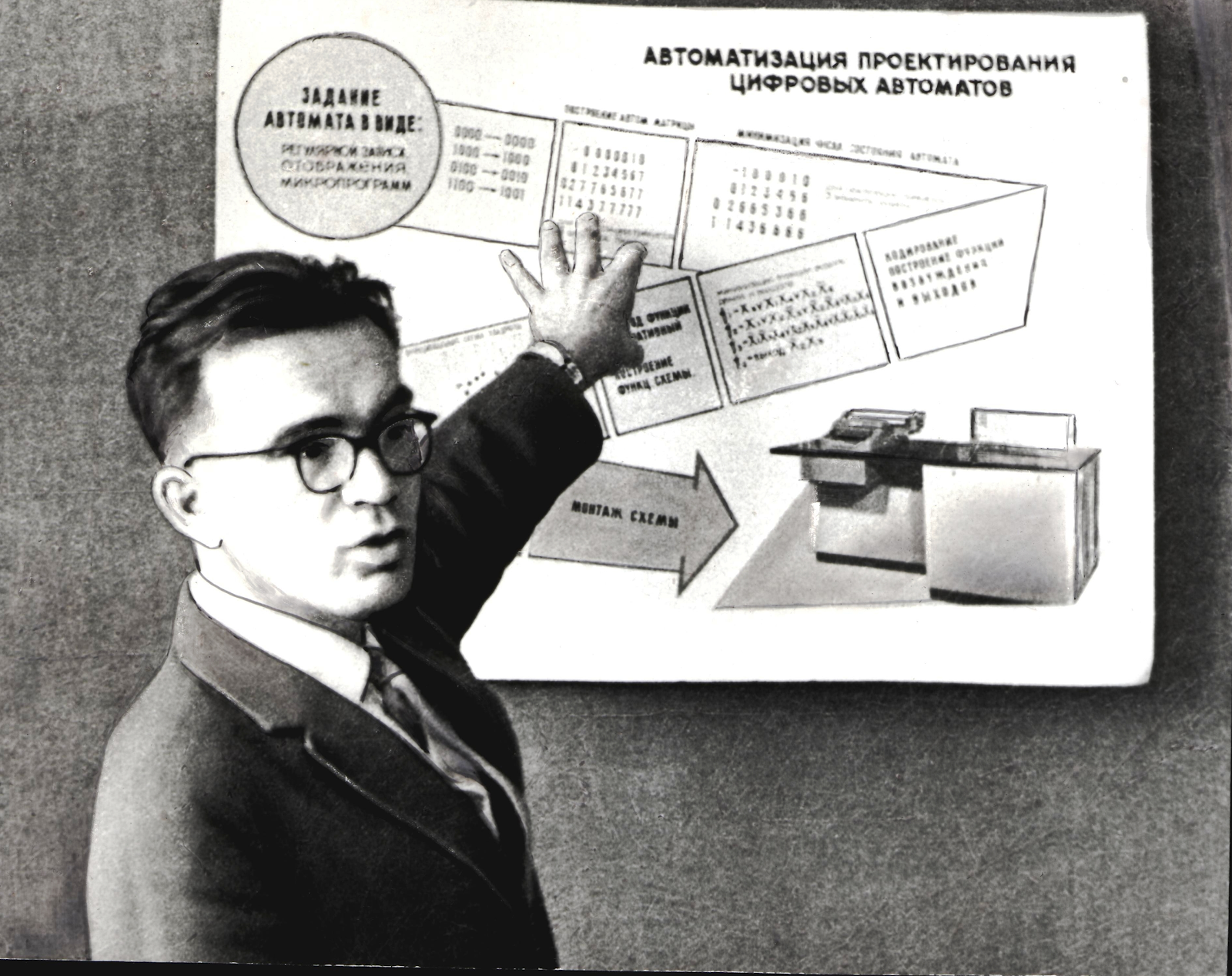
Lecture on Automation of Design of Digital Automata, 1960s
We agreed to make the Lvov system. In 1963, the first landing of employees of the Institute of Cybernetics arrived at the plant to study production, accounting, and document flow. In 1968, they already handed over a standard system that solved five problems: managing the production process, starting from the workplace, workshop, to the level of the entire plant; inventory management logistics; automation of accounting and financial activities; paperless workflow and conference calls. When I wrote an article about this, I specifically checked whether there was something like that in the USA. Did not have. They had small systems that only took into account the logistics, the customer base. From whom to buy, to whom to sell. They did not decide so globally.
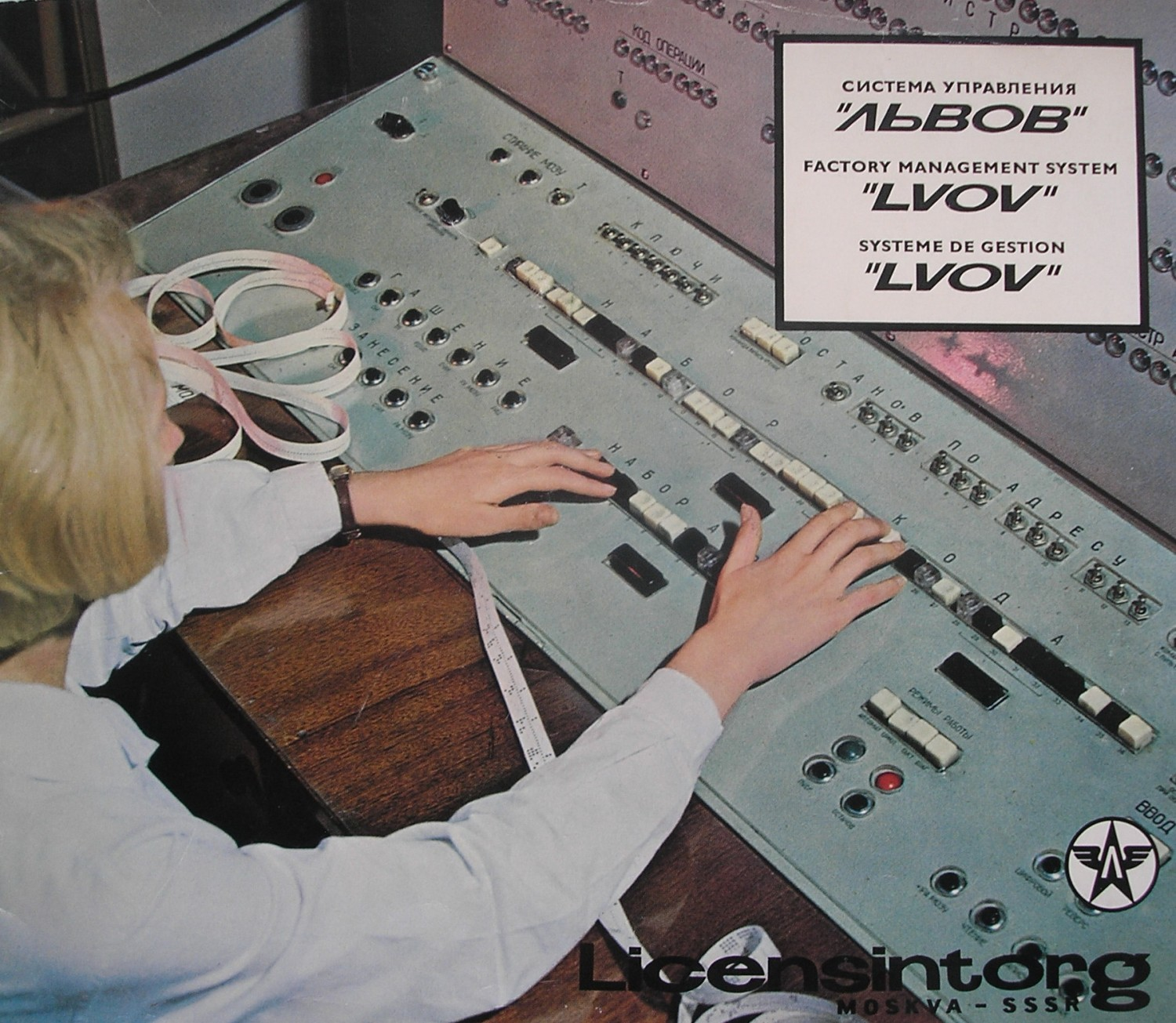
Here again one must understand that in the Soviet Union this was possible because they did not spare funds. As much as necessary, we will add as much. Five tasks are needed - we will write five. Second, we had a more universal education than Americans. They added the financial part to their systems later than we did.
A specialized operating system was developed for the Lviv ACS, the old ones were improved and new peripheral devices and systems were created. The technical basis was first one, and later two Minsk cars.
Another important principle on which the Lviv ACS was based is modularity. The system was made as a constructor. Blocks of functional and system tasks could be separately transferred and reconfigured for other enterprises. This approach is fundamental for modern systems as well.
After the automated control system "Lvov", the creation of a typical system "Kuntsevo" began. My father made it with Muscovites and Leningraders for machine-building plants with different production quantities - from individual machines to mass production.
"Make your own EGSVC!"
When the military came to Glushkov, they said that he could make his own system for them and asked about his wishes, he replied: "So that no economist would cross my threshold." He was so tired of them. In one journal, in my opinion, a philosophical one, even seminars were held with economists to explain to them what this electronic computer technology is for. People did not understand and were afraid of the new. Meanwhile, OGAS could have been created, but in the capitalist world with large machines this was impossible.
How was the EGSVC conceived? The machines would not be at every enterprise, but in collective use centers. It was assumed that people from neighboring factories would come and count there. In military affairs, the Americans could do this, but what about the same stores? They cannot buy a car for themselves, and coming to a shared use center means revealing their trade secrets. Thus, in principle, such economic management for the Americans at that stage was impossible. The capitalist system did not allow it. Digitalization began with the advent of the Internet and personal computers, when they entered every home and every store, and in the 1960-1970s, large enterprises were mainly automated. In the early 1970s, work began on the famous Swift banking system. Because banks could afford to buy and use big machines.
In 1969, the American military project ARPANET came out of the underground. Our management got scared, called Glushkov and said: "Make your own EGSVTs!" This is how the 1973 project appeared. Communication with collective centers was proposed to be done by telephone via modems. The terms of reference took up four hefty volumes. Already on more advanced machines, of course. Father understood that it was possible to make a system, but his plan was never fully implemented. Although the lines about the development of ACS and OGAS can be found in the materials of the 24, 25 and 26 congresses of the CPSU.
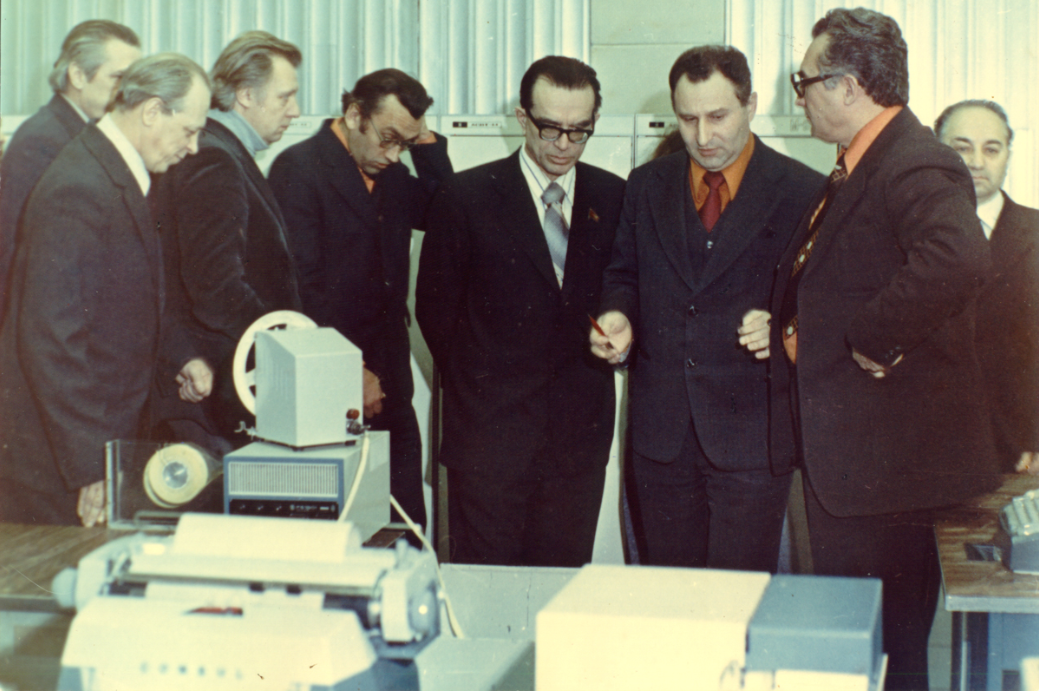
Viktor Mikhailovich Glushkov in Tula at a meeting with chief designers of automated control systems for defense enterprises. 1980 year
Engineer in the kitchen
Since 1963, my father was a member of the IFIP (International Federation for Information Processing) program committee. Then it was the main organization in the world for all cybernetic developments. The story continues today. The son of Nadia Mishchenko, who worked for his father and Lebedev, after his defense went to the University of Berkeley. And there he got into an argument with the teacher - who did the first speech recognition programs. “I remember that my mother had such a program of 1959 or 1958 on her table,” says Sasha. The teacher did not believe it. Then Sasha was not too lazy, went to the US Library of Congress, picked up all the documents. It turned out, indeed, Glushkov spoke at the congress in Munich with this topic and made a splash. After this speech, he was taken to the IFIP program committee. They had 400 words, they had to put together nouns, verbs and prepositions,and the machine had to determine which sentence was meaningful and which was not. The program worked perfectly. According to Nadia, there was only one mistake that she could not correct. The machine refused to perceive the phrase "the engineer is in the kitchen" as meaningful.
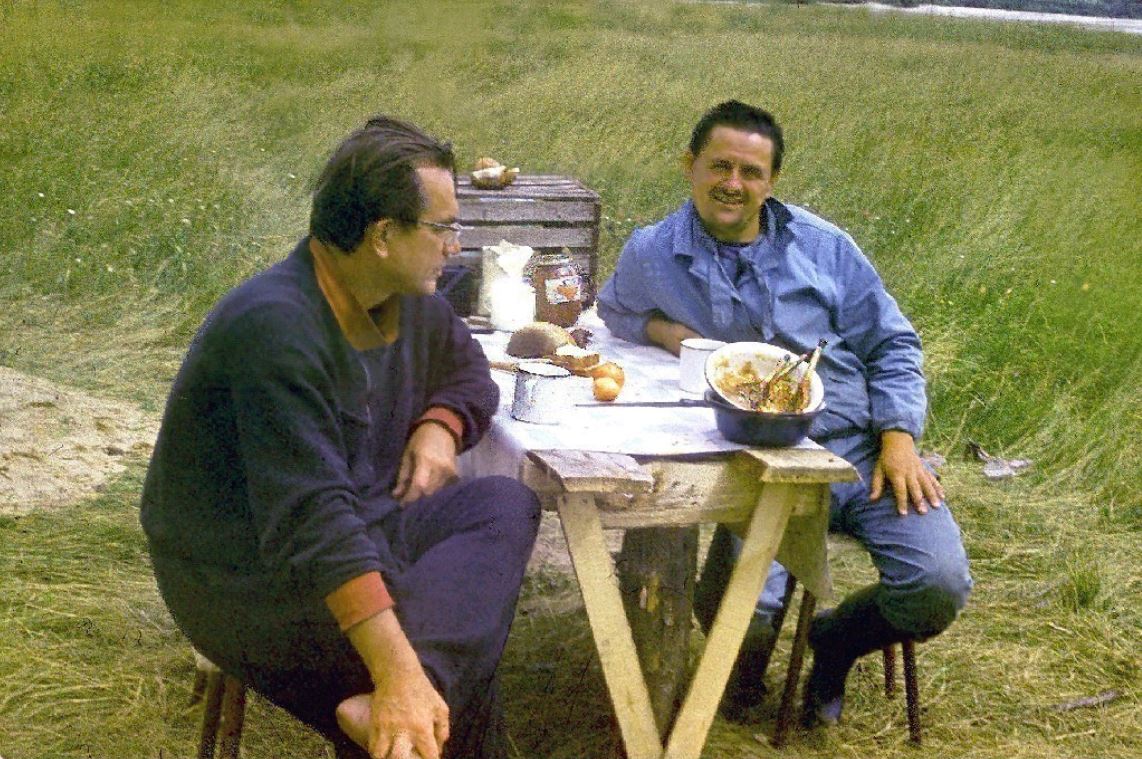
On vacation with Tadeusz Maryanovich , 1970s
History of science and history of commercial success
When they now write about the history of computing technology, modern youth, unfortunately, do not see the general panorama. Most writers are guided by what I call Western history. It is a history of commercial success, but a history of science and a history of commercial success are completely different concepts. In science, the main thing is the struggle of ideas, one must see where they came from, why exactly then, for what they were used. A history of commercial success is essentially a history of startups. For example, Steve Jobs, whom we praise. Like, I assembled a computer in the garage. But he collected, not created! These are two big differences. Uncle Vasya collected things in our garage that no one dreamed of! He could collect a dump truck from factory scraps and what he removed from old cars. It's just that people didn't sell it back then. But he gathered from what was, and was not created by him.
For personal computers, for example, the principle of micro-step programming was first applied in the Kiev "Mira". The mouse, too, was not created by Jobs - another American, etc. Created by some, assembled by others. And in people in the head it is postponed that those who collected it created. But it is not so.
Of course, you have to be a very good engineer to start a successful IT company. You need to understand the topic, the hardware, because this is not an easy matter. I am not belittling Jobs's merits, because a lot of interesting things were done later at Apple. But I repeat: there is a history of science, and there is a history of commercial success. In the history of success, they won, but in the history of science, they did not always win.

Dnepr is one of the most famous control computers developed by the Institute of Cybernetics under the leadership of Viktor Glushkov. Produced throughout the 1960s.
There was no commerce as such in the USSR. For her one could get a term, as for murder now - 20 years. But the masters created this! We have, for example, Zhenya Bondarenko, who made the famous "Worlds" - that was the name of small machines for engineering calculations, the first prototypes of personal computers (1964–1968). He still has radios in his room. All workers, even 1936. Everything is littered with details, as many men love. They did everything from software to the first supercomputers - macro pipelines.